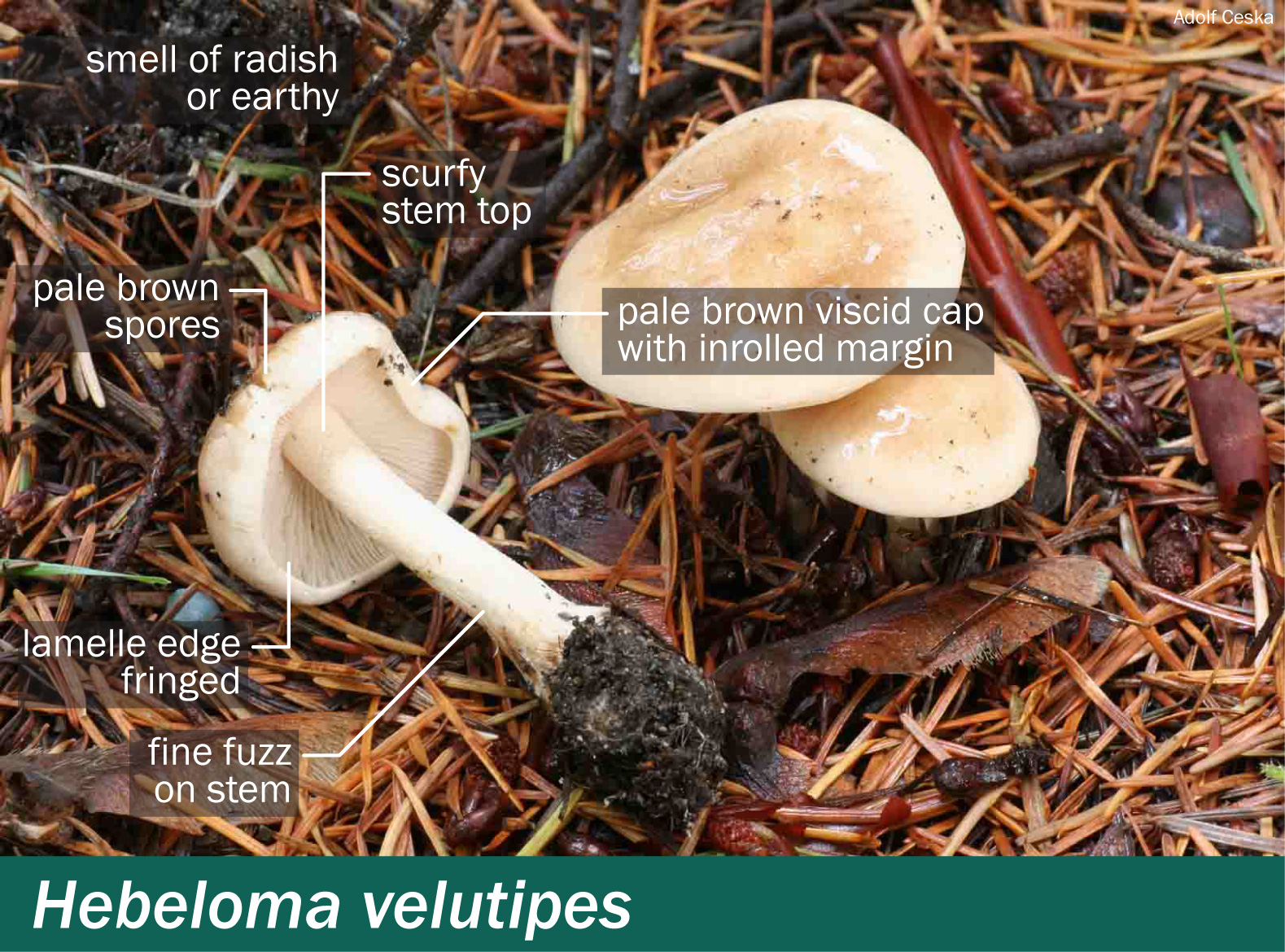Hebeloma velutipes — Velvet foot hebeloma, velvet foot poisonpie
Odour: Usually radish-like or earthy
Taste: Unpleasant, sometimes slightly bitter and radish-like.
Cap: 2-8 cm in diameter, convex with an inrolled margin when young, becoming wavy and flattening as it expands, tan to brown in the middle, lighter around the margin. Surface usually viscid, glistening, moist and slightly sticky to touch.
Gills: Adnate to slightly notched, initially white, turning brown as they age. Bottom edges of gills with delicate fringes (look closely) and frequently also, beads of water.
Stems: 2-10 cm long x 0.4-1.6 cm wide, cylindrical, usually expanding to a club-shaped or bulbous base. Covered by fine 'hairs' giving the stem a slightly fuzzy appearance and the species its name.
Ring or veil: None.
Cup or volva: None.
Spores: 9.5-12.5 x 5.5-7 µm, slightly roughened, turning reddish-brown (dextrinoid reaction) in Melzer's iodine solution.
Habitat: On soil, most often reported under Douglas fir (Pseudotsuga menziesii), western hemlock (Tsuga heterophylla), conifers in Pinaceae, in forests mixed with western red cedar (Thuja plicata) and Garry oak (Quercus garryana)5; ectomycorrhizal.
Geographical range6,7: Northern Hemisphere; New Zealand, where it may have been introduced with planted pine.
Toxins: Identity of toxins is unclear. Only a few Hebeloma species have been analyzed chemically8,9. Hebeloma crustuliniforme and Hebeloma sinapizans, neither of which is particularly close to our species10, contain a triterpene that was toxic to cells9. Surprisingly given the reputation of the genus, three Hebeloma species including H. leucosarx are harvested and sold as food in Mexican markets11. Possibly, the mushrooms eaten in Mexico are not the same as the European and North American species.
Symptoms: Time of onset, presumably between 15 min and 4 hours. Stomach pain, nausea, vomiting, diarrhea8. Symptoms usually finish after 1-2 days.
Treatment: Contact your regional Poison Control Centre if you or someone you know is ill after eating any Hebeloma mushrooms. Poison centres provide free, expert medical advice 24 hours a day, seven days a week. If possible, save the mushrooms or some of the leftover food containing the mushrooms to help confirm identification.
Poison Control:
British Columbia: 604-682-5050 or 1-800-567-8911.
United States (WA, OR, ID): 1-800-222-1222.
Cases of poisoning by Hebeloma species:
- Two dogs in Washington reportedly ate Hebeloma mushrooms and became sick13.
- In Colorado in 2013, two men ate mushrooms tentatively identified (based only on a photograph) as Hebeloma species. About 3/4 hour later after eating the mushrooms the men experienced nausea, vomiting, and sleepiness14.
- In 1926, a Russian family of four in Baltimore, Maryland ate a stew of mixed mushrooms, one of which was later identified as Hebeloma crustuliniforme, albeit partially decomposed. Family members experienced drowsiness followed by nausea and vomiting, and all recovered after a couple of days15.

